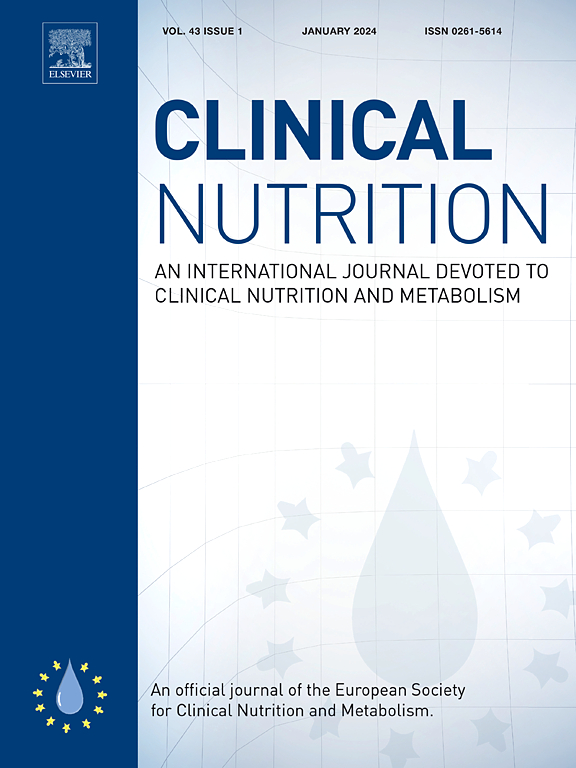肌酸酐与胱抑素C比值与骨骼肌数量和质量的计算机断层测量的关联:动脉粥样硬化的多民族研究。
IF 6.6
2区 医学
Q1 NUTRITION & DIETETICS
引用次数: 0
摘要
背景与目的:骨骼肌(SM)健康在老年和慢性疾病人群中具有重要的预后价值,但由于评估中的挑战,其评估经常被忽略。肌酸酐与胱抑素C比值(CCR)是一种简单的基于血清的测量方法,与测量的SM数量(肌萎缩)和强度密切相关,但其与SM质量(肌骨化症)相关的证据有限且相互矛盾。本研究调查了CCR与计算机断层扫描(CT)测量肌萎缩症和肌骨增生症之间的关系。方法:在这项多民族动脉粥样硬化研究的横断面分析中,纳入了1035名参与者,他们具有完整的身体成分测量和与访问匹配的血清肌酐和胱抑素C测量。CCR计算为(血清肌酐/血清胱抑素C) × 100。用SM指数(SMI;SM面积归一化为体表面积),肌骨化为SM密度(SMD;基于Hounsfield单位)。采用相关分析和多变量线性回归对CCR与SMI和SMD的关系进行建模。结果:CCR与SMI呈正相关(rho = 0.295, p)。结论:CCR与肌萎缩和肌骨增生的CT测量值相关;然而,对于CKD患者应谨慎使用。本文章由计算机程序翻译,如有差异,请以英文原文为准。
Association of creatinine-to-cystatin C ratio with computed tomography measures of skeletal muscle quantity and quality: The multi-ethnic study of atherosclerosis
Background & aims
Skeletal muscle (SM) health has significant prognostic value in geriatric and chronic disease populations, yet its assessment is frequently omitted due to challenges in evaluation. The creatinine-to-cystatin C ratio (CCR) is a simple serum-based measure that associates well with measured SM quantity (myopenia) and strength, but evidence for its association with SM quality (myosteatosis) is limited and conflicting. This study investigated the association between CCR and computed tomography (CT) measures of myopenia and myosteatosis.
Methods
In this cross-sectional analysis of the Multi-Ethnic Study of Atherosclerosis, 1035 participants with complete body composition measurements and visit-matched serum creatinine and cystatin C measurements were included. CCR was calculated as (serum creatinine/serum cystatin C) x 100. Myopenia was quantified as SM index (SMI; SM area normalized for body surface area) and myosteatosis as SM density (SMD; based on Hounsfield units) from CT images. Correlation analyses and multivariable linear regression were used to model the relationships of CCR with SMI and SMD.
Results
CCR was positively correlated and associated with SMI (rho = 0.295, p < 0.001; adjusted β 0.071 per 1 % increase in CCR, standard error [SE] 0.032, 95 % confidence interval [CI] 0.009 to 0.133, p = 0.026) and SMD (rho = 0.417, p < 0.001; adjusted β 0.040 per 1 % increase in CCR, SE 0.006, 95 % CI 0.027 to 0.052, p < 0.001). However, the associations were weaker in participants with chronic kidney disease (CKD), particularly for SMD (interaction p = 0.005).
Conclusions
CCR is associated with CT measures of myopenia and myosteatosis; however, it should be used cautiously in patients with CKD.
求助全文
通过发布文献求助,成功后即可免费获取论文全文。
去求助
来源期刊

Clinical nutrition
医学-营养学
CiteScore
14.10
自引率
6.30%
发文量
356
审稿时长
28 days
期刊介绍:
Clinical Nutrition, the official journal of ESPEN, The European Society for Clinical Nutrition and Metabolism, is an international journal providing essential scientific information on nutritional and metabolic care and the relationship between nutrition and disease both in the setting of basic science and clinical practice. Published bi-monthly, each issue combines original articles and reviews providing an invaluable reference for any specialist concerned with these fields.
 求助内容:
求助内容: 应助结果提醒方式:
应助结果提醒方式:


